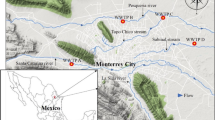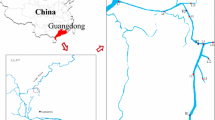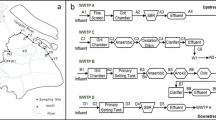Abstract
The current study highlights the occurrence, spatial distribution, and risk assessment of 16 endocrine-disrupting chemicals (EDCs) including their transformation products (TPs) in the wastewater and surface water of Lahore, Pakistan, using solid-phase extraction followed by liquid chromatography–mass spectrometry and gas chromatography–mass spectrometry. The parent EDCs include bisphenol A (BPA), triclosan (TCS), triclocarban (TCC), estrone (E1), estradiol (E2), estriol (E3), ethinylestradiol (EE2), 4-n-octylphenol (4n-OP), and 4-n-nonylphenol (4n-NP). The TPs include two TPs each of BPA, TCC, and estrogens along with a TP of TCS. Most EDCs showed 100% detection frequency in the wastewater with highest median concentration of 1310 ng/L for E3. In the surface water, the highest median concentration was, however, observed for BPA (54.6 ng/L). Spatial variations in terms of sum of concentration due to all EDCs and their TPs were observed at different sampling points which suggest contamination due to industrial waste from nearby industrial estate. Risk evaluation in terms of risk quotient (RQ) and estradiol equivalent factor (EEQ) showed that most of EDCs and their TPs could pose high risk and estrogenicity to the surrounding environment. From the results of the current study, it is observed that the environment of Pakistan is deteriorating and is potential risk for endocrine disruption. It is, therefore, recommended to take stringent measures to make it sustainable for current as well as for future generations.







Similar content being viewed by others
Data availability
The datasets used and/or analyzed during the current study are available from the corresponding author on reasonable request.
References
Andra, S. S., Charisiadis, P., Arora, M., van Vliet-Ostaptchouk, J. V., & Makris, K. C. (2015). Biomonitoring of human exposures to chlorinated derivatives and structural analogs of bisphenol A. Environment International, 85, 352–379.
Archer, E., Petrie, B., Kasprzyk-Hordern, B., & Wolfaardt, G. M. (2017). The fate of pharmaceuticals and personal care products (PPCPs), endocrine disrupting contaminants (EDCs), metabolites and illicit drugs in a WWTW and environmental waters. Chemosphere, 174, 437–446.
Armstrong, D. L., Rice, C. P., Ramirez, M., & Torrents, A. (2017). Influence of thermal hydrolysis-anaerobic digestion treatment of wastewater solids on concentrations of triclosan, triclocarban, and their transformation products in biosolids. Chemosphere, 171, 609–616.
Ashfaq, M., Li, Y., Wang, Y., Chen, W., Wang, H., Chen, X., Wu, W., Huang, Z., Yu, C. P., & Sun, Q. (2017b). Occurrence, fate, and mass balance of different classes of pharmaceuticals and personal care products in an anaerobic-anoxic-oxic wastewater treatment plant in Xiamen, China. Water Research, 123, 655–667.
Ashfaq, M., Khan, K. N., Rehman, M. S. U., Mustafa, G., Nazar, M. F., Sun, Q., Iqbal, J., Mulla, S. I., & Yu, C. P. (2017a). Ecological risk assessment of pharmaceuticals in the receiving environment of pharmaceutical wastewater in Pakistan. Ecotoxicology and Environmental Safety, 136, 31–39.
Ashfaq, M., Sun, Q., Zhang, H., Li, Y., Wang, Y., Li, M., Lv, M., Liao, X., & Yu, C. P. (2018b). Occurrence and fate of bisphenol A transformation products, bisphenol A monomethyl ether and bisphenol A dimethyl ether, in wastewater treatment plants and surface water. Journal of Hazardous Materials, 357, 401–407.
Ashfaq, M., Li, Y., Wang, Y., Qin, D., Rehman, M. S. U., Rashid, A., Yu, C. P., & Sun, Q. (2018a). Monitoring and mass balance analysis of endocrine disrupting compounds and their transformation products in an anaerobic-anoxic-oxic wastewater treatment system in Xiamen, China. Chemosphere, 204, 170–177.
Ashfaq, M., Li, Y., Rehman, M. S. U., Zubair, M., Mustafa, G., Nazar, M. F., Yu, C. P., & Sun, Q. (2019a). Occurrence, spatial variation and risk assessment of pharmaceuticals and personal care products in urban wastewater, canal surface water, and their sediments: A case study of Lahore, Pakistan. Science of the Total Environment, 688, 653–663.
Ashfaq, M., Sun, Q., Ma, C., Rashid, A., Li, Y., Mulla, S. I., & Yu, C.-P. (2019b). Occurrence, seasonal variation and risk evaluation of selected endocrine disrupting compounds and their transformation products in Jiulong river and estuary, China. Marine Pollution Bulletin, 145, 370–376.
Atkinson, S. K., Marlatt, V. L., Kimpe, L. E., Lean, D. R., Trudeau, V. L., & Blais, J. M. (2012). The occurrence of steroidal estrogens in south-eastern Ontario wastewater treatment plants. Science of the Total Environment, 430, 119–125.
Balabanič, D., Rupnik, M., & Klemenčič, A. K. (2011). Negative impact of endocrine-disrupting compounds on human reproductive health. Reproduction, Fertility and Development, 23(3), 403–416.
Barber, L. B., Loyo-Rosales, J. E., Rice, C. P., Minarik, T. A., & Oskouie, A. K. (2015). Endocrine disrupting alkylphenolic chemicals and other contaminants in wastewater treatment plant effluents, urban streams, and fish in the Great Lakes and Upper Mississippi River Regions. Science of the Total Environment, 517, 195–206.
Behera, S. K., Kim, H. W., Oh, J.-E., & Park, H.-S. (2011). Occurrence and removal of antibiotics, hormones and several other pharmaceuticals in wastewater treatment plants of the largest industrial city of Korea. Science of the Total Environment, 409(20), 4351–4360.
Belhaj, D., Baccar, R., Jaabiri, I., Bouzid, J., Kallel, M., Ayadi, H., & Zhou, J. L. (2015). Fate of selected estrogenic hormones in an urban sewage treatment plant in Tunisia (North Africa). Science of the Total Environment, 505, 154–160.
Bhandari, R. K., Deem, S. L., Holliday, D. K., Jandegian, C. M., Kassotis, C. D., Nagel, S. C., Tillitt, D. E., Vom Saal, F. S., & Rosenfeld, C. S. (2015). Effects of the environmental estrogenic contaminants bisphenol A and 17α-ethinyl estradiol on sexual development and adult behaviors in aquatic wildlife species. General and Comparative Endocrinology, 214, 195–219.
Blair, B., Nikolaus, A., Hedman, C., Klaper, R., & Grundl, T. (2015). Evaluating the degradation, sorption, and negative mass balances of pharmaceuticals and personal care products during wastewater treatment. Chemosphere, 134, 395–401.
Bouissou-Schurtz C, Houeto P, Guerbet M, Bachelot M, Casellas C, Mauclaire AC, et al. (2014). Ecological risk assessment of the presence of pharmaceutical residues in a French national water survey. Regulatory Toxicology and Pharmacology, 69, 296–303
Burkhardt-Holm, P. (2010). Endocrine disruptors and water quality: A state-of-the-art review. International Journal of Water Resources Development, 26(3), 477–493.
Chiaia-Hernandez, A. C., Krauss, M., & Hollender, J. (2012). Screening of lake sediments for emerging contaminants by liquid chromatography atmospheric pressure photoionization and electrospray ionization coupled to high resolution mass spectrometry. Environmental Science & Technology, 47(2), 976–986.
Diamanti-Kandarakis, E., Bourguignon, J. P., Giudice, L. C., Hauser, R., Prins, G. S., Soto, A. M., Zoeller, R. T., & Gore, A. C. (2009). Endocrine-disrupting chemicals: An endocrine society scientific statement. Endocrine Reviews, 30(4), 293–342.
Englert, B. (2007). Method 1694: Pharmaceuticals and personal care products in water, soil, sediment, and biosolids by HPLC/MS/MS. US Environmental Protection Agency (EPA). Retrieved from
Gabet-Giraud, V., Miège, C., Choubert, J., Ruel, S. M., & Coquery, M. (2010). Occurrence and removal of estrogens and beta blockers by various processes in wastewater treatment plants. Science of the Total Environment, 408(19), 4257–4269.
Gmurek, M., Olak-Kucharczyk, M., & Ledakowicz, S. (2017). Photochemical decomposition of endocrine disrupting compounds–A review. Chemical Engineering Journal, 310, 437–456.
Gutiérrez-Gómez, A. A., SanJuan-Reyes, N., Galar-Martínez, M., Dublán-García, O., Islas-Flores, H., Pérez-Alvárez, I., & Gómez-Oliván, L. M. (2016). 17 β-estradiol induced oxidative stress in gill, brain, liver, kidney and blood of common carp (Cyprinus carpio). Electronic Journal of Biology, 12(1), 53–63.
Halden, R. U., & Paull, D. H. (2005). Co-occurrence of triclocarban and triclosan in US water resources. Environmental Science & Technology, 39(6), 1420–1426.
Ibor, O. R., Nnadozie, P., Ogarekpe, D. M., Idogho, O., Anyanti, J., Aziobu, D., Onyezobi, C., Chukwuka, A. V., Adeougn, A. O., & Arukwe, A. (2022). Public health implications of endocrine disrupting chemicals in drinking water and aquatic food resources in Nigeria: A state-of-the-science review. Science of the Total Environment, 858(2), 159835.
Jürgens, M. D., Holthaus, K. I., Johnson, A. C., Smith, J. J., Hetheridge, M., & Williams, R. J. (2002). The potential for estradiol and ethinylestradiol degradation in English rivers. Environmental Toxicology and Chemistry: An International Journal, 21(3), 480–488.
Kolpin, D. W., Furlong, E. T., Meyer, M. T., Thurman, E. M., Zaugg, S. D., Barber, L. B., & Buxton, H. T. (2002). Pharmaceuticals, hormones, and other organic wastewater contaminants in US streams, 1999–2000: A national reconnaissance. Environmental Science & Technology, 36(6), 1202–1211.
Komesli, O., Muz, M., Ak, M., Bakırdere, S., & Gokcay, C. (2015a). Occurrence, fate and removal of endocrine disrupting compounds (EDCs) in Turkish wastewater treatment plants. Chemical Engineering Journal, 277, 202–208.
Krogh, K., Halling-Sørensen, B., Mogensen, B., & Vejrup, K. (2003). Environmental properties and effects of nonionic surfactant adjuvants in pesticides: A review. Chemosphere, 50(7), 871–901.
Kumar, V., Nakada, N., Yasojima, M., Yamashita, N., Johnson, A. C., & Tanaka, H. (2011). The arrival and discharge of conjugated estrogens from a range of different sewage treatment plants in the UK. Chemosphere, 82(8), 1124–1128.
Kwon, J. W., & Xia, K. (2012). Fate of triclosan and triclocarban in soil columns with and without biosolids surface application. Environmental Toxicology and Chemistry, 31(2), 262–269.
Le, T. A. H. (2012). The Yes assay as a tool to analyse endocrine disruptors in different matrices in Vietnam. Universitäts-und Landesbibliothek Bonn.
Lozano, N., Rice, C. P., Ramirez, M., & Torrents, A. (2013). Fate of triclocarban, triclosan and methyltriclosan during wastewater and biosolids treatment processes. Water Research, 47(13), 4519–4527.
Lu, J., Wu, J., Stoffella, P. J., & Wilson, P. C. (2012). Analysis of bisphenol A, nonylphenol, and natural estrogens in vegetables and fruits using gas chromatography–tandem mass spectrometry. Journal of Agricultural and Food Chemistry, 61(1), 84–89.
Lv, M., Sun, Q., Xu, H., Lin, L., Chen, M., & Yu, C.-P. (2014). Occurrence and fate of triclosan and triclocarban in a subtropical river and its estuary. Marine Pollution Bulletin, 88(1–2), 383–388.
Majeed, S., Rashid, S., Qadir, A., Mackay, C., & Hayat, F. (2018). Spatial patterns of pollutants in water of metropolitan drain in Lahore, Pakistan, using multivariate statistical techniques. Environmental Monitoring and Assessment, 190(3), 128.
Manickum, T., & John, W. (2014). Occurrence, fate and environmental risk assessment of endocrine disrupting compounds at the wastewater treatment works in Pietermaritzburg (South Africa). Science of the Total Environment, 468, 584–597.
Markey, C. M., Rubin, B. S., Soto, A. M., & Sonnenschein, C. (2002). Endocrine disruptors: From Wingspread to environmental developmental biology. The Journal of Steroid Biochemistry and Molecular Biology, 83(1), 235–244.
McCormick, J. M., Van Es, T., Cooper, K. R., White, L. A., & Haggblom, M. M. (2011). Microbially mediated O-methylation of bisphenol a results in metabolites with increased toxicity to the developing zebrafish (Danio rerio) embryo. Environmental Science & Technology, 45(15), 6567–6574.
Miller, T. R., Heidler, J., Chillrud, S. N., Delaquil, A., Ritchie, J. C., Mihalic, J. N., Bopp, R., & Halden, R. U. (2008). Fate of triclosan and evidence for reductive dechlorination of triclocarban in estuarine sediments. Environmental Science & Technology, 42(12), 4570.
Miller, T. R., Colquhoun, D. R., & Halden, R. U. (2010). Identification of wastewater bacteria involved in the degradation of triclocarban and its non-chlorinated congener. Journal of Hazardous Materials, 183(1), 766–772.
Padilla-Sánchez, J., Plaza-Bolaños, P., Romero-González, R., Barco-Bonilla, N., Martínez-Vidal, J., & Garrido-Frenich, A. (2011). Simultaneous analysis of chlorophenols, alkylphenols, nitrophenols and cresols in wastewater effluents, using solid phase extraction and further determination by gas chromatography–tandem mass spectrometry. Talanta, 85(5), 2397–2404.
Qiang, Z., Dong, H., Zhu, B., Qu, J., & Nie, Y. (2013). A comparison of various rural wastewater treatment processes for the removal of endocrine-disrupting chemicals (EDCs). Chemosphere, 92(8), 986–992.
Saha, S., Narayanan, N., Singh, N., & Gupta, S. (2022). Occurrence of endocrine disrupting chemicals (EDCs) in river water, ground water and agricultural soils of India. International Journal of Environmental Science and Technology, 19(11), 11459–11474.
Shi, J., Liu, X., Chen, Q., & Zhang, H. (2014). Spatial and seasonal distributions of estrogens and bisphenol A in the Yangtze River Estuary and the adjacent East China Sea. Chemosphere, 111, 336–343.
Souchier, M., Benali-Raclot, D., Benanou, D., Boireau, V., Gomez, E., Casellas, C., & Chiron, S. (2015). Screening triclocarban and its transformation products in river sediment using liquid chromatography and high resolution mass spectrometry. Science of the Total Environment, 502, 199–205.
Sun, Q., Wang, Y., Li, Y., Ashfaq, M., Dai, L., Xie, X., & Yu, C.-P. (2017). Fate and mass balance of bisphenol analogues in wastewater treatment plants in Xiamen City, China. Environmental Pollution, 225, 542–549.
Toft, G., & Baatrup, E. (2003). Altered sexual characteristics in guppies (Poecilia reticulata) exposed to 17β-estradiol and 4-tert-octylphenol during sexual development. Ecotoxicology and Environmental Safety, 56(2), 228–237.
Tohidi, F., & Cai, Z. (2017). Fate and mass balance of triclosan and its degradation products: Comparison of three different types of wastewater treatments and aerobic/anaerobic sludge digestion. Journal of Hazardous Materials, 323, 329–340.
Vega-Morales, T., Sosa-Ferrera, Z., & Santana-Rodríguez, J. J. (2013). Evaluation of the presence of endocrine-disrupting compounds in dissolved and solid wastewater treatment plant samples of Gran Canaria Island (Spain). BioMed Research International, 2013, 790570.
Venkatesan, A. K., Pycke, B. F., Barber, L. B., Lee, K. E., & Halden, R. U. (2012). Occurrence of triclosan, triclocarban, and its lesser chlorinated congeners in Minnesota freshwater sediments collected near wastewater treatment plants. Journal of Hazardous Materials, 229, 29–35.
Verlicchi P., Al Aukidy M., Zambello E. (2012). Occurrence of pharmaceutical compounds in urban wastewater: removal, mass load and environmental risk after a secondary treatment—a review. Science of the Total Environment, 429, 123–155.
Wang, Q., & Kelly, B. C. (2017). Occurrence and distribution of synthetic musks, triclosan and methyl triclosan in a tropical urban catchment: Influence of land-use proximity, rainfall and physicochemical properties. Science of the Total Environment, 574, 1439–1447.
Wang, S., Zhu, Z., He, J., Yue, X., Pan, J., & Wang, Z. (2018). Steroidal and phenolic endocrine disrupting chemicals (EDCs) in surface water of Bahe River, China: Distribution, bioaccumulation, risk assessment and estrogenic effect on Hemiculter leucisculus. Environmental Pollution, 243, 103–114.
Windsor, F. M., Ormerod, S. J., & Tyler, C. R. (2018). Endocrine disruption in aquatic systems: Up-scaling research to address ecological consequences. Biological Reviews, 93(1), 626–641.
Yu, Y., Wu, L., & Chang, A. C. (2013). Seasonal variation of endocrine disrupting compounds, pharmaceuticals and personal care products in wastewater treatment plants. Science of the Total Environment, 442, 310–316.
Acknowledgements
Mr. Lifeng Lin and Ms. Xu Liao are appreciated for their help in the maintenance of HPLC–MSMS and GC–MS and Environmental Protection Agency (EPA) Punjab, Pakistan, for providing facility of solid-phase extraction (SPE).
Funding
This work was supported by National Natural Science Foundation of China (U1805244, 41673099), Chinese Academy of Sciences (CAS) President’s International fellowship (award number 2015PE004) for Postdoctoral Researchers, and Youth Innovation Promotion Association CAS (2016280).
Author information
Authors and Affiliations
Contributions
MA and QS conceived and designed the study. MA, QS, YL, MSUR, and MZ performed the experimental work. MA, QS, SHS, MFN, MTF, GM, and HA evaluated the data, and MA and QS wrote the manuscript. All authors read and agreed for submission of final manuscript.
Corresponding authors
Ethics declarations
Conflict of interest
The authors declare that they have no competing interests.
Consent to participate
Not applicable.
Consent for publication
Not applicable.
Ethical approval
Not applicable.
Additional information
Publisher's Note
Springer Nature remains neutral with regard to jurisdictional claims in published maps and institutional affiliations.
Supplementary Information
Below is the link to the electronic supplementary material.
Rights and permissions
Springer Nature or its licensor (e.g. a society or other partner) holds exclusive rights to this article under a publishing agreement with the author(s) or other rightsholder(s); author self-archiving of the accepted manuscript version of this article is solely governed by the terms of such publishing agreement and applicable law.
About this article
Cite this article
Ashfaq, M., Li, Y., Zubair, M. et al. Occurrence and risk evaluation of endocrine-disrupting chemicals in wastewater and surface water of Lahore, Pakistan. Environ Geochem Health 45, 4837–4851 (2023). https://doi.org/10.1007/s10653-023-01527-6
Received:
Accepted:
Published:
Issue Date:
DOI: https://doi.org/10.1007/s10653-023-01527-6




